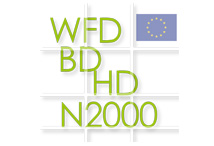Freshwater Policy Briefs
Freshwater Thought Pieces

(click to enlarge)
The increasing demand by citizens and environmental organisations for cleaner rivers and lakes, groundwater and coastal beaches has been evident for considerable time. This has recently been reconfirmed by a representative opinion poll Eurobarometer in all 25 EU countries: When asked to list the five main environmental issues that Europeans are worried about, averaged results for the EU25 show that nearly half of the respondents are worried about “water pollution” (47%), with figures for individual countries going up as far as 71%.
This demand by citizens is one of the main reasons why the Commission has made water protection one of the priorities of its work. The new European Water Policy will get polluted waters clean again, and ensure clean waters are kept clean.
European Water Policy has undergone a thorough restructuring process and the Water Framework Directive – adopted in 2000 – is now the operational tool, setting the objectives for water protection for the future. It commits member states to achieve good qualitative and quantitative status of all water bodies.
Get more information about the WFD on the European Commission website.
The Habitats Directive (together with the Birds Directive) forms the cornerstone of Europe's nature conservation policy. It is built around two pillars: the Natura 2000 network of protected sites and the strict system of species protection. All in all the directive protects over 1.000 animals and plant species and over 200 so called "habitat types" (e.g. special types of forests, meadows, wetlands, etc.), which are of European importance.
Get more information about the Habitats Directive on the European Commission website.
It is the EU’s oldest piece of nature legislation and one of the most important, creating a comprehensive scheme of protection for all wild bird species naturally occurring in the Union. Its was adopted unanimously by the Member States in 1979 as a response to increasing concern about the declines in Europe's wild bird populations resulting from pollution, loss of habitats as well as unsustainable use. It was also in recognition that wild birds, many of which are migratory, are a shared heritage of the Member States and that their effective conservation required international co-operation.
The directive recognises that habitat loss and degradation are the most serious threats to the conservation of wild birds. It therefore places great emphasis on the protection of habitats for endangered as well as migratory species (listed in Annex I), especially through the establishment of a coherent network of Special Protection Areas (SPAs) comprising all the most suitable territories for these species. Since 1994 all SPAs form an integral part of the Natura 2000 ecological network.
Get more information about the Birds Directive on the European Commission website.
The EU Biodiversity Strategy aims to halt the loss of biodiversity and ecosystem services in the EU and help stop global biodiversity loss by 2020. It reflects the commitments taken by the EU in 2010, within the international Convention on Biological Diversity.
Get more information about the Biodiversity Strategy on the European Commission website.
Natura 2000 is the centrepiece of EU nature and biodiversity policy. It is an EU-wide network of nature protection areas established under the 1992 Habitats Directive. The aim of the network is to assure the long-term survival of Europe's most valuable and threatened species and habitats. It is comprised of Special Areas of Conservation (SAC) designated by Member States under the Habitats Directive, and also incorporates Special Protection Areas (SPAs) which they designated under the 1979 Birds Directive. Natura 2000 is not a system of strict nature reserves where all human activities are excluded. The establishment of this network of protected areas also fulfils a Community obligation under the UN Convention on Biological Diversity.
Get more information about the Natura 2000 network on the European Commission website.



